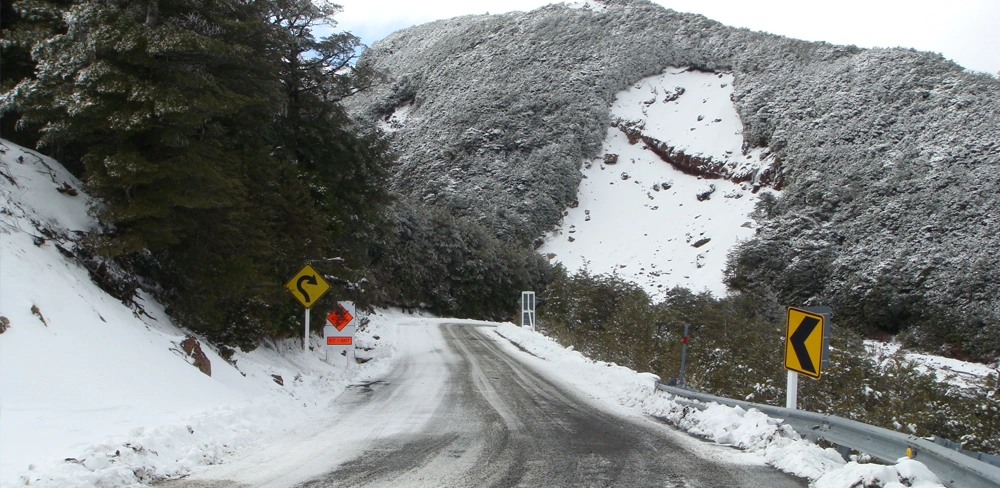- New Zealand weather conditions can change very quickly and the winter months, from June until August, can be the most dangerous time of the year.
- Snow can be unpredictable, occurring suddenly in areas like the central North Island and alpine passes in the South Island. These conditions are often found higher up in the alpine region, but they can also occur in main centres like Christchurch, Dunedin and Invercargill.
- Most winter resorts require snow chains to be carried at all times. Weather conditions can change very quickly in the alpine environment, with snow storms arriving suddenly at any time during the day.
- On some New Zealand roads during winter, you can be fined for not carrying snow chains. On most alpine passes in New Zealand snow chains must be carried at all times.
- New Zealand’s alpine passes include the Lindis Pass, Crown Range, Burke Pass, Lewis Pass, Arthur’s Pass and the Milford Rd (SH94) to Te Anau. Before travelling through these areas, it always pays to check the weather forecast and road conditions.

Winter Driving Conditions
- In winter it is very important to drive to the conditions and allow extra distance when following other vehicles.
- It is important that customers using Snowsweat snow chains stay on the road and follow the tracks of other vehicles when travelling on fresh snow.
- The best traction can be found following the tracks of other vehicles where there is less chance of hitting an unmarked hazard in the snow.
- More information on winter driving can be found on the New Zealand Transport Agency website

Before you go:
- Check your manual – Always check your vehicle manual for advice on using snow chains.
- Sufficient wheel clearance – You must be able to drive safely with snow chains fitted.
- Scrape off snow and ice – From all windows, side mirrors, headlights and brake lights. Don’t use hot water to clear snow and ice off a cold windscreen – that cracking sound won’t be the ice.
- Check the forecast – And plan your route for safety, using the latest national road report on Roadwatch.
- Practice at home first – Get the hang of fitting and tensioning snow chains on your tyres at home; it’s harder to learn in a howling blizzard.
- 2WD – Your snow chains must be fitted to the driving wheels to get traction.
- 4WD – Check the vehicle’s owners manual for instructions on using snow chains. Modern 4WD’s may not have enough clearance around the front wheels to safely fit snow chains – check your owners manual for information on your vehicle.
- AWD – Check the vehicle’s owners manual for instructions on using snow chains. Be careful you don’t damage driving or ABS sensors that may be located near the wheels.
- Check your chains – Before each use check for any damage or breakages.
- Check your tyres – Your tyres should be at normal road tyre pressure when using Snowsweat snow chains.
Hitting the road:
- Steer away from the hard stuff – Remove snow chains once you leave the snow behind.
- Drive to the conditions – This means travelling no faster than 20km/h on snowy roads.
- Keep it steady – Try to keep the vehicle moving without spinning the wheels.
- Brake gently – Start softly and only apply more pressure as the vehicle starts to slow. Keeping brake pressure smooth will avoid locking up the wheels.
- Brake on the straight – Before turning into a corner. Take the corner at a safe speed and start to accelerate again when the vehicle is straight again.
- Accelerate steadily – If you feel the vehicle start to wheel spin, ease back the pressure on the accelerator pedal until you feel the tyres start to grip again.
- Learn to read the conditions – Bridges and overpasses ice over faster than roads because they are more exposed and don’t have the warmth of the earth underneath. Gullies and shaded corners tend to ice over quicker and thaw slower than open road surfaces, as they are not exposed to direct sunlight. Hard packed snow will turn to ice when it freezes, making the conditions more dangerous at night and early in the morning.
- Increase your following distance: Your vehicle will take longer to stop on a slippery surface like snow or ice.
- Deep snow: If you get stuck in a deep snow drift use a shovel to clear the snow around the vehicle and create a track for the tyres to move through. You’ll get better traction once you’re on ground with less snow covering.
- Black ice: Or invisible ice. Common in shady areas and on bridges at night or early in the morning during winter. Reduce speed and increase following distances. Choose carefully where you brake to prevent skidding or sliding.
When you reach your destination:
Clean your chains – Clean dirt, snow or ice off your chains after each use to prevent surface rusting. We recommend shaking off the ice and snow after you have used them and leaving them out of the bag to dry overnight.




